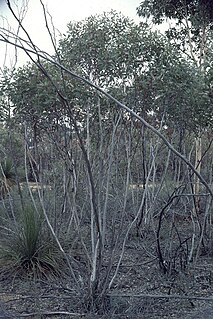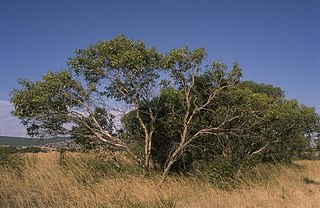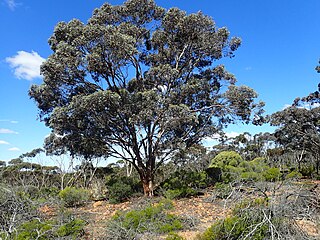
Eucalyptus capillosa, commonly known as wheatbelt wandoo, or mallee wandoo, is a species of tree or mallee that is endemic to Western Australia. It has smooth, grey bark, lance-shaped to elliptic adult leaves, spindle-shaped flower buds in groups of nine to thirteen, white flowers and barrel-shaped to cylindrical fruit.

Eucalyptus cooperiana, commonly known as the many-flowered mallee, is a species of mallee that is endemic to an area along the south coast of Western Australia. It is described as being "of striking appearance by reason of its smooth, white bark and acutely angled branchlets". It has lance-shaped adult leaves, flower buds in groups of between nine and thirteen or more, creamy yellow flowers and urn-shaped fruit.
Eucalyptus exigua is a species of mallee that is endemic to Western Australia. It has smooth, whitish bark, linear to narrow lance-shaped adult leaves, flower buds in groups of between seven and eleven, white flowers and short barrel-shaped to conical fruit.

Eucalyptus exilis, commonly known as Boyagin mallee, is a species of mallee that is endemic to Western Australia. It has thin stems with smooth bark, lance-shaped adult leaves, flower buds in groups of eleven, white flowers and barrel-shaped to shortened spherical fruit.

Eucalyptus georgei, commonly known as Hyden blue gum, is a species of tree or mallet that is endemic to Western Australia. It has smooth bark, glossy green, lance-shaped adult leaves, glaucous flower buds in groups of between seven and eleven, creamy white flowers and conical to cup-shaped fruit.

Eucalyptus gittinsii, commonly known as northern sandplain mallee, is a species of mallee that is endemic to Western Australia. It has smooth greyish bark, sometimes with rough flaky bark near the base, lance-shaped to curved adult leaves, flower buds in groups of three, whitish flowers and cylindrical to barrel-shaped fruit.

Eucalyptus incrassata, commonly known as the lerp mallee, yellow mallee, ridge fruited mallee or rib fruited mallee, is a species of mallee that is endemic to southern Australia. It has smooth bark, sometimes with rough, ribbony bark near the base, lance-shaped adult leaves, flower buds in groups of seven, creamy white, pale yellow, sometimes pink or red flowers, and cylindrical, barrel-shaped or bell-shaped fruit.
Eucalyptus litorea, commonly known as saline mallee, is a species of mallee that is endemic to a small area on the southern coast of Western Australia. It has hard, rough grey bark on the trunk, smooth grey bark above, lance-shaped adult leaves, flower buds in groups of seven, white flowers and cylindrical or barrel-shaped fruit.

Eucalyptus luteola is a species of mallee that is endemic to a small area of Western Australia. It has smooth grey bark with rough greyish ribbons near the base, linear to narrow lance-shaped adult leaves, flower buds in groups of eleven to thirteen, lemon-coloured flowers and cylindrical to barrel-shaped fruit.
Eucalyptus ordiana is a species of small tree or a mallee that is endemic to the Kimberley area of Western Australia. It has smooth, powdery bark, egg-shaped leaves, flower buds in groups of seven, white flowers and cup-shaped fruit.

Eucalyptus phaenophylla, also known as common southern mallee, is a species of mallee that is endemic to Western Australia. It has smooth bark, linear to narrow lance-shaped or narrow elliptical adult leaves, flower buds in groups of up to thirteen, pale lemon-coloured flowers and barrel-shaped, cylindrical or conical fruit.
Eucalyptus tephroclada is a species of mallee that is endemic to the southwest of Western Australia. It has smooth bark, lance-shaped adult leaves, flower buds in pendent groups of nine to thirteen, pale lemon yellow flowers and barrel-shaped to cup-shaped fruit.
Eucalyptus thamnoides is a species of mallee that is endemic to south western Western Australia. It has smooth bark, lance-shaped adult leaves, flower buds in groups of seven, cream-coloured to pale yellow flowers and cup-shaped, conical or bell-shaped fruit.

Eucalyptus clivicola, commonly known as green mallet, is a species of eucalypt that is endemic to Western Australia. It has smooth bark, linear to lance-shaped adult leaves, flower buds in groups of between nine and thirteen, pale yellow flowers and barrel-shaped, conical or cylindrical fruit.

Eucalyptus densa is a species of mallee or mallet that is endemic to Western Australia. It has smooth greyish bark that is shed in curly strips, linear to narrow lance-shaped adult leaves, long, spindle-shaped flower buds in groups of seven or nine, pale yellow or lemon-coloured flowers and conical, cylindrical or barrel-shaped fruit.

Eucalyptus extrica, commonly known as eastern tallerack, is a species of mallee that is endemic to Western Australia. It has smooth bark, lance-shaped adult leaves arranged in opposite pairs, flower buds in groups of three, whitish flowers and cylindrical to barrel-shaped fruit.

Eucalyptus alatissima is a mallee that is endemic to central parts of the Great Victoria Desert. It has rough bark on the lower part of its stems, smooth tan to cream-coloured bark on its upper parts, egg-shaped to lance-shaped leaves and buds in groups of three. The buds have a powdery covering and are prominently winged.
Eucalyptus aridimontana is a mallee that is endemic to a small area in the Pilbara region of Western Australia. It has smooth bark, lance-shaped adult leaves, flower buds in groups of seven or nine, white flowers and barrel-shaped fruit.

Eucalyptus canescens, commonly known as the Ooldea Range mallee or Beadell's mallee, depending on subspecies, is a species of mallee that is endemic to southern Australia. It has rough bark from the base of the trunk to the thicker branches, smooth bark on the thin branches, egg-shaped to lance-shaped adult leaves, flower buds in groups of between seven and eleven, creamy white flowers and smooth cup-shaped to conical, and sometimes ribbed fruit.
Eucalyptus frenchiana is a species of mallet that is endemic to Western Australia. It has smooth bark, narrow lance-shaped, glossy green adult leaves, ribbed flower buds in groups of three, white flowers and ribbed, conical to cup-shaped fruit.
















